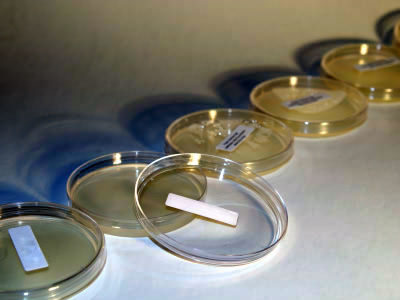A biodegradable and easily recyclable 'substrate made of mushrooms' is created

Chips installed in electronic devices are indispensable in modern society, but a large amount of electronic waste is generated every year due to the life of chips and the difficulty of recycling. Therefore, an Austrian research team announced research results that sustainable chips can be manufactured by using 'mushrooms' as the material of the chip
MycelioTronics: Fungal mycelium skin for sustainable electronics | Science Advances
https://dx.doi.org/DOI:%2010.1126/sciadv.add7118
Fungal skin replaces plastics in electronics - European Biotechnology
https://european-biotechnology.com/up-to-date/latest-news/news/fungal-skin-replaces-plastics-in-electronics.html
Computer chip made using mushroom skin could be easily recycled | New Scientist
https://www.newscientist.com/article/2346702-computer-chip-made-using-mushroom-skin-could-be-easily-recycled/
An electronic circuit made of conductive metal is placed on a base called a substrate, which serves as insulation and cooling. Most substrates are made of plastic polymers that can not be recycled, and when the life of the chip expires it is often thrown away as it is, contributing to the generation of 50 million tons of electronic waste annually .
Therefore, a research team at Johannes Kepler University in Australia conducted research to make a chip substrate using Ganoderma lucidum (Ganoderma lucidum) , a mushroom of the Ganoderma family . The idea of making a substrate out of mushrooms may seem strange, but there are already attempts to make animal leather-like materials using mushroom mycelium as a raw material, and the mycelium-derived leather ' Mylo ' has reached the point of commercialization.
Leather-like material 'Mylo' made from mushrooms - GIGAZINE

Growing on the surface of rotten wood, the ganoderma mycelium forms a tough crust to protect the inside from bacteria and other fungi. By extracting and drying this outer skin, it is said that a material with flexibility and excellent insulation performance will be completed. The research team reports that this material has the same thickness as paper but can withstand high temperatures exceeding 200 degrees Celsius, and has properties suitable for electronic circuit boards.
The research team also conducted a demonstration experiment to build a metal circuit on a substrate actually made from mycelia, and confirmed that it exhibited almost the same conductivity performance as a standard plastic polymer. The mycelium-derived material can be used even if it is bent more than 2000 times, and it can also be used as a battery for low-power devices such as Bluetooth sensors.


Professor Andrew Adamatzky of the University of West England , UK, who was not involved in this research, commented to the scientific media New Scientist, ``The prototype created is impressive, and the research results are groundbreaking.'' did.
Related Posts:







